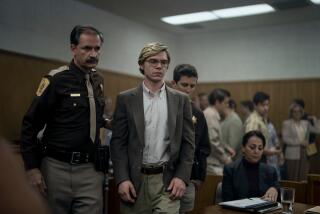What really happened in the Manson murders? ‘Chaos’ casts doubt on Helter Skelter theory
As a salacious moment, the Manson murders had it all: sex, drugs, rock ’n’ roll, racial discord, Hollywood, mind-control and dune buggies. The Manson murders have been hailed as epochal: the needle scratch to the 1960s soundtrack of peace, love and mellow vibes that brought the idealistic era to a screeching halt. It’s an angle central to Quentin Tarantino’s “Once Upon a Time in Hollywood,” one of the summer’s most-anticipated movies nearly half a century after the events it depicts.
Amid the mythologization, the facts — beyond the precincts of wild-eyed conspiracy theorists — have largely existed in steady-state. Among them: that Manson meant to incite a race war and that he singled out Sharon Tate’s home, site of the bloodiest carnage, to terrorize ex-resident Terry Melcher, whom he accused of reneging on a record deal. This wisdom is received from Vincent Bugliosi, the prosecutor who put away Manson and his “family” and whose bestseller “Helter Skelter” is considered the definitive account of the case. Four years after Bugliosi’s death, Tom O’Neill’s “Chaos” explodes a bomb under Manson’s Helter Skelter race war, and Bugliosi’s posthumous reputation.
Book lovers! Sign up for the new L.A. Times Book Club for upcoming author events »
“Chaos” originated as a 1999 magazine commission to mark the Manson murders’ 30th anniversary. Failing to heed fellow journalist Paul Krassner — “Be careful, Tom. This will take over your life if you let it” — O’Neill disappeared down the rabbit-hole, blowing his deadline. Instead, he sold a publisher on a book that, chasing down still more leads, he failed to deliver. Finally, he found a home for his now-opus at Little, Brown — in time for the 50th anniversary. It’s worth recounting this tortured history in considering “Chaos,” a flawed, tantalizing, at times unduly conspiratorial work. Still, founded on prodigious research, it convincingly impugns key tenets of Bugliosi’s narrative and exhumes a trove of provocative data.
The most explosive revelations concern the motive Bugliosi ascribed to Manson. This held that the murders (five people were killed in Tate’s home and on the property; Leno and Rosemary LaBianca were killed the night after) were committed as part of an “eschatological” scheme (resting on a tendentious reading of Beatles’ lyrics to their song “Helter Skelter” and Scripture). By staging the murders to appear to be the work of the Black Panthers, Manson hoped to incite backlash against blacks and all-out war between white liberals and conservatives, after which Black Muslims (having dodged the earlier bloodshed) would vanquish everyone except Manson, who, at the head of his followers ( which would swell to 144,000 — “a pure white master race”), would emerge from his desert bolt-hole to assume his rightful place as a post-apocalyptic plantation boss attended by “black servants.”
Where did Melcher come in? The record producer was gatekeeper to the album through which Manson would rally his flock in the first place.
From Manson’s ludicrous acid-spiked ravings, Bugliosi posited a grand unified motive that explained the murders’ best-known target, method and established the culpability of Manson, who didn’t kill anyone himself — as far as we know — but rather ordered acolytes to do so. Pivotal to it: Melcher, supposedly petrified of Manson, was medicated to testify at his trial.
However, contrary to what the court was told, O’Neill discovers two archived accounts placing Melcher with Manson after the murders — hardly suggestive of someone in fear for his life — one with the references apparently struck out by Bugliosi’s hand.
Why might Bugliosi gin up this grandiose motive? O’Neill speculates that he may have been protecting Hollywood notables (Melcher was Doris Day’s son) or that he may have wanted to advance his political ambitions and sell books. Few cops believed it, preferring a more pedestrian motive. “Helter Skelter was ‘not a motive...but a philosophy,’” one tells O’Neill.
But the strongest, if most perverse, lead O’Neill unearths stems from a prior family killing. Two ex-detectives who worked that case cite a recording (later ruled illegal and erased) of a jailhouse phone call — alluded to at the time by Manson co-prosecutor Aaron Stovitz. Just before the Tate-LaBianca murders, the call was made by Bobby Beausoleil, who’d been arrested in the killing of Gary Hinman, imploring his fellow family members to help him and “leave a sign.” In this scheme, the murders were conceived to spring Beausoleil from custody by replicating the look of Hinman’s killing — frenzied stabbing, some variant of “pig” daubed in victims’ blood at the scene — which suggested that the killer remained at large. The logic — mass murder to cover up a single homicide — is warped, but this wasn’t a cohort long on rational decision-making.
It took police three months to nab Manson and family, during which time they were suspected of further killings, despite police surveillance, including what O’Neill dubs “the biggest [raid] in the history of Los Angeles law enforcement at that time” on Manson’s compound. Indeed, “Chaos” depicts a career criminal on probation who led a charmed life despite run-ins over drugs, firearms, even statutory rape — none of which led to charges or even a revoked parole. O’Neill also documents the solicitousness of Manson’s San Francisco parole officer, ever-ready to vouch for his character. It’s striking how Manson transmogrified from hardened ex-con to acid-slinging cult leader under the noses of authorities as a drop-in at the Haight Ashbury Free Medical Clinic, where he was treated as a research subject, fodder for a later-published commune study.
O’Neill’s 20-year investigation reads like a thriller with overtones of Philip Marlowe and Lew Archer: its narrator cast as a white knight truth-seeker probing cold corruption amid sunlit glare. Among the low-lifes, unreliable narrators, burnouts, spectral figures and missing records is Bugliosi, morphing from hovering presence — monitoring O’Neill’s investigations from afar — to browbeating nemesis. The late Bugliosi can’t defend himself, but O’Neill digs up a troubling story, first reported by The Times in 1974, sourced from legal proceedings and police reports, that Bugliosi beat “his mistress” to the point that she miscarried their baby, then camped out at her house until she recanted her story to police.
What to make of everything?
As O’Neill concedes, the storylines suggested by his findings cannot “coexist.” For example, the notion that Manson was a law enforcement or intelligence collaborator beggars belief and remains entirely conjectural. Much of what O’Neill found is strictly circumstantial, like Manson’s supposed influence by Louis West, a CIA-funded mind-control researcher, brainwasher and UCLA faculty member who once created a “laboratory disguised as a hippie crash pad” in San Francisco’s Haight neighborhood. Despite O’Neill’s efforts, a direct connection proves elusive. And for all of O’Neill’s self-awareness of the undertow of conspiracy theorizing, I wonder if, in his zeal to assemble “the pieces” of the Manson “puzzle,” he doesn’t slight incompetence and distraction — those reliable agents of human affairs. I suspect also that stories become more, not less, embellished with time. Nonetheless, he’s performed yeoman’s work filling out an aging narrative straitjacketed by the exigencies of its author’s legal strategy.
::
“Chaos: Charles Manson, the CIA, and the Secret History of the Sixties”
Tom O’Neill with Dan Piepenbring
Little, Brown: 528 pp., $30
Phillips’ writing has appeared in the Economist, the Wall Street Journal, Smithsonian, the Irish Times and other publications.
More to Read
Sign up for our Book Club newsletter
Get the latest news, events and more from the Los Angeles Times Book Club, and help us get L.A. reading and talking.
You may occasionally receive promotional content from the Los Angeles Times.






